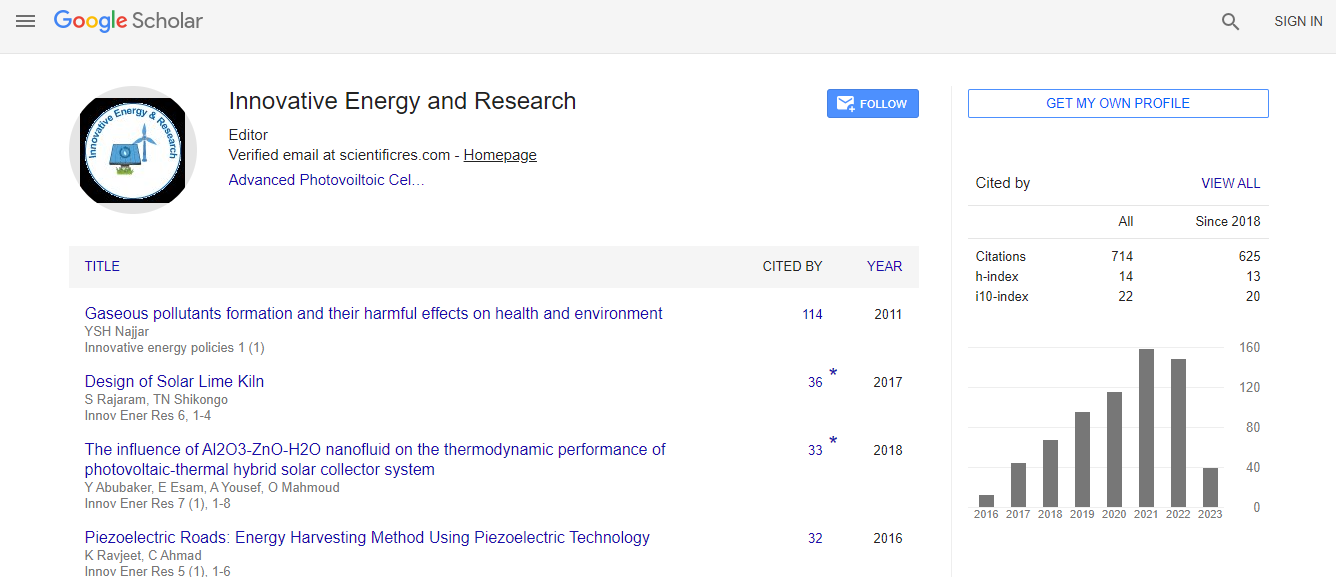Our Group organises 3000+ Global Conferenceseries Events every year across USA, Europe & Asia with support from 1000 more scientific Societies and Publishes 700+ Open Access Journals which contains over 50000 eminent personalities, reputed scientists as editorial board members.
Open Access Journals gaining more Readers and Citations
700 Journals and 15,000,000 Readers Each Journal is getting 25,000+ Readers
Google Scholar citation report
Citations : 712
Innovative Energy & Research received 712 citations as per Google Scholar report
Innovative Energy & Research peer review process verified at publons
Indexed In
- Google Scholar
- Open J Gate
- Genamics JournalSeek
- RefSeek
- Hamdard University
- EBSCO A-Z
- Publons
- Euro Pub
- ICMJE
Useful Links
Recommended Journals
Related Subjects
Share This Page
Hydrogen generation in metal water reaction and strategies of storage
20th International Conference on Advanced Energy Materials and Research
Jerzy. A. Szpunar
University of Saskatchewan, Canada
Keynote: Innov Ener Res
Abstract
Hydrogen has been recognized as a clean and sustainable fuel. However still many problems have to be to be solved in area of generation, transport and storage of this fuel for future hydrogen based economy to be realized. Some of our research in this area will be presented. Reaction of water with activated aluminum powder is consider as one of the methods to generate hydrogen. The reaction produces also aluminum hydroxide (Al (OH) 3 or AlOOH) as the byproduct; these compounds change to alumina (Al2O3) after calcination process, and alumina can produce aluminum [1, 2]. Hydrogen production rate can be increased if effective surface area of aluminum exposed to oxidation is increased. We found that microstructural refinement can be used to promote the reaction and allow major increase of the production of hydrogen. The addition of water soluble salts (potash or salt) also allow to increase the oxidation rate and hydrogen generation. However, we established that presence of salt has smaller influence than microstructural modifications. The storage of hydrogen will also require structural modification of the storage system. One of storage system that was developed by our team will be discussed [3]. We designed a Pd-graphene composite for hydrogen storage with spherical shaped nanoparticles of 45 nm size homogeneously distributed over a graphene substrate. This new hydrogen storage system has attractive features like high gravimetric density, ambient conditions of hydrogen charge and low temperature of the hydrogen discharge. The palladium particles produce a low activation energy barrier to dissociate Plenarythis helps delaying the formation of metallic clusters and can improve hydrogen storage in metal graphene systems. Recent Publications 1. Razavi-Tousi, J.A. Szpunar, Effect of addition of water-soluble salts on the hydrogen generation of aluminium in reaction with hot water, Journal of Alloys and Compounds, 679 (2016) 364-374. 2. Razavi-Tousi, J.A. Szpunar, Microstructural evolution and grain subdivision mechanisms during severe plastic deformation of aluminum particles by ball milling, Philosophical Magazine, 95 (2015) 1425-1447. 3. C.Y. Zhou, J.A. Szpunar, X.Y. Cui, Synthesis of Ni/graphene nanocomposite for hydrogen storage, ACS Applied Materials & Interfaces, 8 (2016) 15232-15241. 4. A. Choudhary, L. Malakkal, R.K. Siripurapu, B. Szpunar, J.A.Szpunar, First principles calculations of hydrogen storage on Cu and Pd-decorated graphene, International Journal of Hydrogen Energy, 41 (2016) 17652-17656. 5. O. Faye, U. Eduok, J. Szpunar, B. Szpunar, A. Samoura, A. Beye, Hydrogen Storage on bare Cu atom and Cu-functionalized boron-doped graphene: a first Principles study, International Journal of Hydrogen Energy, 42 (2017) 4233-4243.Biography
Jerzy. A. Szpunar, joined the Department of Mechanical Engineering at the University of Saskatchewan in August 2009, as Tier I Canada Research Chair. He came from McGill University where he was Professor of Materials Science and Birks Chair in Metallurgy. His research interests extend to various areas of materials related investigations. More recently his research has focused on environmentally friendly energy generation, in particular the extraction and purification of hydrogen, accident tolerant nuclear fuel and research on advanced materials for Generation IV nuclear reactors. His research supports also various clean energy programs and research on more safe and secure materials for oil and gas transportation. Dr Szpunar has a strong record of research productivity. 40 PhD students and 27 MSc. students graduated under his supervision. He is an author and co-author of more than 900 research papers.
E-mail: jerzy.szpunar@usask.ca

 Spanish
Spanish  Chinese
Chinese  Russian
Russian  German
German  French
French  Japanese
Japanese  Portuguese
Portuguese  Hindi
Hindi 
